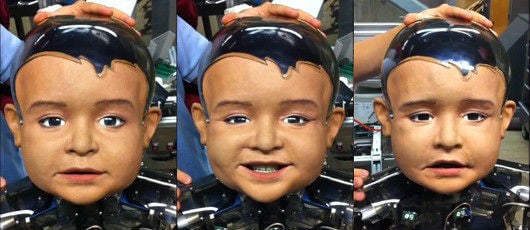A university-led collaboration to develop social robots has publicly unveiled its work in progress: a robotic one-year-old boy. As reported by Gizmag, the android named Diego-san is larger than a typical one-year-old child at over four feet tall and has a head developed by Hanson Robotics with a body made by the Japanese robot manufacturer Kokoro Co.
With 27 moving parts in its face and cameras in its eyes, Diego-san is able to produce a range of infant-like facial expressions that will be used in the development of human interaction software.
Check out the video to see whether or not you can read the bot’s emotions:
In addition to using the robot to push technological limits of robotics artificial intelligence, Diego-san will be used to study childhood social development and sensory-motor skills, such as infant interactions with others and control of facial expressions for social response. The Machine Perception Lab at UCSD, which is overseeing the project, has also partnered up with researchers from the University of Miami and University of Washington who are interested in early childhood development and motor control, according to Science Daily. Through the collaboration, software will be developed to allow Diego-san to control its body and better interact with people.
Kokoro has been hard at work collaborating with others to develop telepresence robots that appear natural. Before this version of Diego-san, the company had developed a previous version of the baby robot in 2010, but its face was off putting. Actually, it was downright creepy. At the same time, Hanson Robotics has been creating robots that look life-like and convey emotions through facial expression. One of the most popular developments was a head of Albert Einstein that could smile and frown. It seems like a perfect pairing then for Hanson to work with Kokoro.
With 43 muscles in the human face, the task of creating a robot to mimic the entire gamut of expressions is daunting. In order for robots to be eventually viewed as being ‘human’, nonverbal communication of emotions is essential. The great challenge of course is eliminating what is known as the Uncanny Valley, that awkward feeling that something looks kind of human but artificial enough to create uneasiness. It makes sense to start small and focus on infant expressions first, which is why Diego-san is not alone as other robotics groups are trying to generate their own infantile androids.
The development of androids that are indistinguishable from humans is on the pathway to the future of society. But beyond taking our jobs away, these bots are also important because they can open up possibilities for new kinds of research, medical therapies, and understanding into human behavior and communication. The bots may look creepy now, but it won’t be too long before we watch in awe a video of what appears to be an infant but is actually a machine.
If you aren’t familiar with David Hanson’s work, it’s worth checking out his 2009 TED talk in which he talks about designing robots that show emotions. It is a window into how the problem of mimicking human behavior will be solved:




